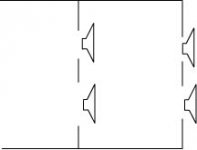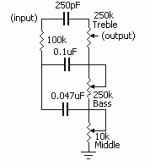Hi,
Its a half watt amplifier. The bigger the driver you partner with it
the likely the more volume you will get as driver efficiency is closely
related to the (total) size of the driver(s).
(which is why is works well with a huge 4x12)
At 1/2 a watt though normal instrument speakers are not your
only option. The other option is something like a 3 watt TV speaker,
these can be found very cheap, and with unusual impedances, but
the main thing is they are usually relatively efficient for their size.
🙂/sreten.
Its a half watt amplifier. The bigger the driver you partner with it
the likely the more volume you will get as driver efficiency is closely
related to the (total) size of the driver(s).
(which is why is works well with a huge 4x12)
At 1/2 a watt though normal instrument speakers are not your
only option. The other option is something like a 3 watt TV speaker,
these can be found very cheap, and with unusual impedances, but
the main thing is they are usually relatively efficient for their size.
🙂/sreten.
Thanks for the reply. I would never have thought of using a 12” for it. I think I’ll start by putting in an 8” fullrange, they come cheap. Is 89 dB sensitive enough to get a sufficient audio level? (I’m guessing that the answer is yes)
Experimenting with small fullranges is a good idea, I’ll do that.
Frimer
Experimenting with small fullranges is a good idea, I’ll do that.
Frimer
Hi,
You want as much dB/W as possible. A 4x4" TV speaker special ?
e.g. you can get a 4" TV speaker ~ 92dB/W, x 4 series/parallel = 98dB/W.
🙂/sreten.
You want as much dB/W as possible. A 4x4" TV speaker special ?
e.g. you can get a 4" TV speaker ~ 92dB/W, x 4 series/parallel = 98dB/W.
🙂/sreten.
I was just looking at the datasheets for the LM386 and saw that it comes in a 386N-4 version that can be run from 18 volts (2 9v batteries). I’ll try to find someplace that stocks that chip.
For the speakers I am looking at something like this . Should they be connected like shown in the attached drawing?
For the speakers I am looking at something like this . Should they be connected like shown in the attached drawing?
Attachments
Whoah....... that is one hot claimed sensitivity.
Same comment on the cheaper smaller driver.
possibly at 0.5m or some other "method".
But reading between the lines ~ 90dB/W is more likely correct.
Personally I'd avoid any cheap driver with the glint of chrome,
usually said bits are hideously resonant and not pleasant,
but said bits are easily removed. It is the sort of thing you
want if you can find cheap, but too expensive for a 4x5":
http://www.allangordon.co.uk/Drivers/Guitar-Speakers.htm
Note the 10" celestion tube 10 is £15 ...........
The wiring diagram is correct, but note the LM386N-4 version
produces its 1 W into a 32 ohm load, so the LM386N-3 version
is probably better if you want a small seperate amplifier that
can drive 8 ohm loads - only one battery required too.
🙂/sreten.
Same comment on the cheaper smaller driver.
possibly at 0.5m or some other "method".
But reading between the lines ~ 90dB/W is more likely correct.
Personally I'd avoid any cheap driver with the glint of chrome,
usually said bits are hideously resonant and not pleasant,
but said bits are easily removed. It is the sort of thing you
want if you can find cheap, but too expensive for a 4x5":
http://www.allangordon.co.uk/Drivers/Guitar-Speakers.htm
Note the 10" celestion tube 10 is £15 ...........
The wiring diagram is correct, but note the LM386N-4 version
produces its 1 W into a 32 ohm load, so the LM386N-3 version
is probably better if you want a small seperate amplifier that
can drive 8 ohm loads - only one battery required too.
🙂/sreten.
i built a small amp using the same chip (lol i got all the parts from a awnsering machine)
i didnt use the mosfet, i used a diffrent circuit
my amp actually blew a 1watt 8 ohm speaker with the thing hooked to a 9V battery. it worked great, lots a distortion too 🙂
(i do belive my chip was the 12 volt version... but with less voltage came more distortion and it just sounded too cool as an effect so i left the 9v in there)
i built it on a board the size of a creditcard and gave it to my dad for fathers day... after mounting it in an old cb exterior speaker cabnet and mounting a speaker i got from a set of computer speakers... i think it was about 25w 16ohm... i cant rember
i know one thing though... turn it ALL the way down before turning it on...
i almost deafened myself trying to get sound out of it with the speaker up to my head... fixed a loose connection and BOOM my ears rang all day... but no damage to the project... good luck!
p.s. i actually started picking up fm radio stations...
you may want to sheild this..
i didnt use the mosfet, i used a diffrent circuit
my amp actually blew a 1watt 8 ohm speaker with the thing hooked to a 9V battery. it worked great, lots a distortion too 🙂
(i do belive my chip was the 12 volt version... but with less voltage came more distortion and it just sounded too cool as an effect so i left the 9v in there)
i built it on a board the size of a creditcard and gave it to my dad for fathers day... after mounting it in an old cb exterior speaker cabnet and mounting a speaker i got from a set of computer speakers... i think it was about 25w 16ohm... i cant rember
i know one thing though... turn it ALL the way down before turning it on...
i almost deafened myself trying to get sound out of it with the speaker up to my head... fixed a loose connection and BOOM my ears rang all day... but no damage to the project... good luck!
p.s. i actually started picking up fm radio stations...
you may want to sheild this..
- Status
- Not open for further replies.
- Home
- Live Sound
- Instruments and Amps
- Practise amp

